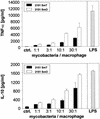Control of mycobacterial replication in human macrophages: roles of extracellular signal-regulated kinases 1 and 2 and p38 mitogen-activated protein kinase pathways
- PMID: 12183542
- PMCID: PMC128221
- DOI: 10.1128/IAI.70.9.4961-4967.2002
Control of mycobacterial replication in human macrophages: roles of extracellular signal-regulated kinases 1 and 2 and p38 mitogen-activated protein kinase pathways
Abstract
Intracellular persistence of mycobacteria may result from an intricate balance between bacterial replication and signaling events leading to antimicrobial macrophage activities. Using human monocyte-derived macrophages, we investigated the relevance of mitogen-activated protein kinase activation for the growth control of Mycobacterium avium isolates differing in their abilities to multiply intracellularly. The highly replicative smooth transparent morphotype of M. avium strain 2151 induced significantly less p38 and extracellular signal-regulated kinases 1 and 2 (ERK1/2) phosphorylation than the smooth opaque morphotype of the same strain, which was gradually eliminated from macrophage cultures. Inhibition of the p38 pathway by highly specific inhibitors did not significantly affect mycobacterial replication within macrophages, regardless of the in vitro virulence of the M. avium strain. However, repression of the ERK1/2 pathway further enhanced intracellular growth of highly replicative M. avium strains, although it did not increase survival of the poorly replicating M. avium isolate. Inhibition of the ERK1/2 pathway resulted in decreased tumor necrosis alpha (TNF-alpha) secretion irrespective of the virulence of the M. avium isolate used for infection, revealing that TNF-alpha could have been only partially responsible for the control of intracellular M. avium growth. In conclusion, ERK1/2- and TNF-alpha-independent pathways are sufficient to limit intramacrophage growth of less-virulent M. avium strains, but early ERK1/2 activation in infected macrophages is critically involved in controlling the growth of highly replicative M. avium strains.
Figures





References
-
- Belisle, J. T., K. Klaczkiewicz, P. J. Brennan, W. R. J. Jacobs, and J. M. Inamine. 1993. Rough morphological variants of Mycobacterium avium. Characterization of genomic deletions resulting in the loss of glycopeptidolipid expression. J. Biol. Chem. 268:10517-10523. - PubMed
-
- Bøyum, A. 1968. Isolation of mononuclear cells and granulocytes from human blood. Isolation of mononuclear cells by one centrifugation, and of granulocytes by combining centrifugation and sedimentation at 1 g. Scand. J. Clin. Lab. Investig. Suppl. 97:77-89. - PubMed
-
- Cano, E., and L. C. Mahadevan. 1995. Parallel signal processing among mammalian MAPKs. Trends Biochem. Sci. 20:117-122. - PubMed
Publication types
MeSH terms
Substances
LinkOut - more resources
Full Text Sources
Molecular Biology Databases
Miscellaneous

